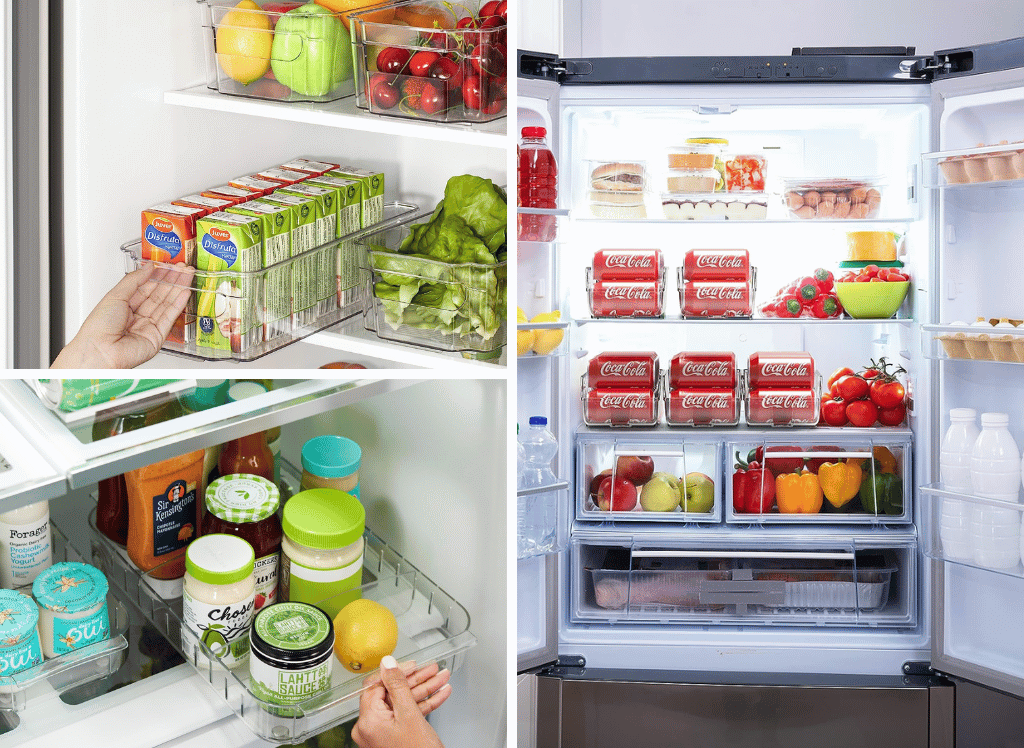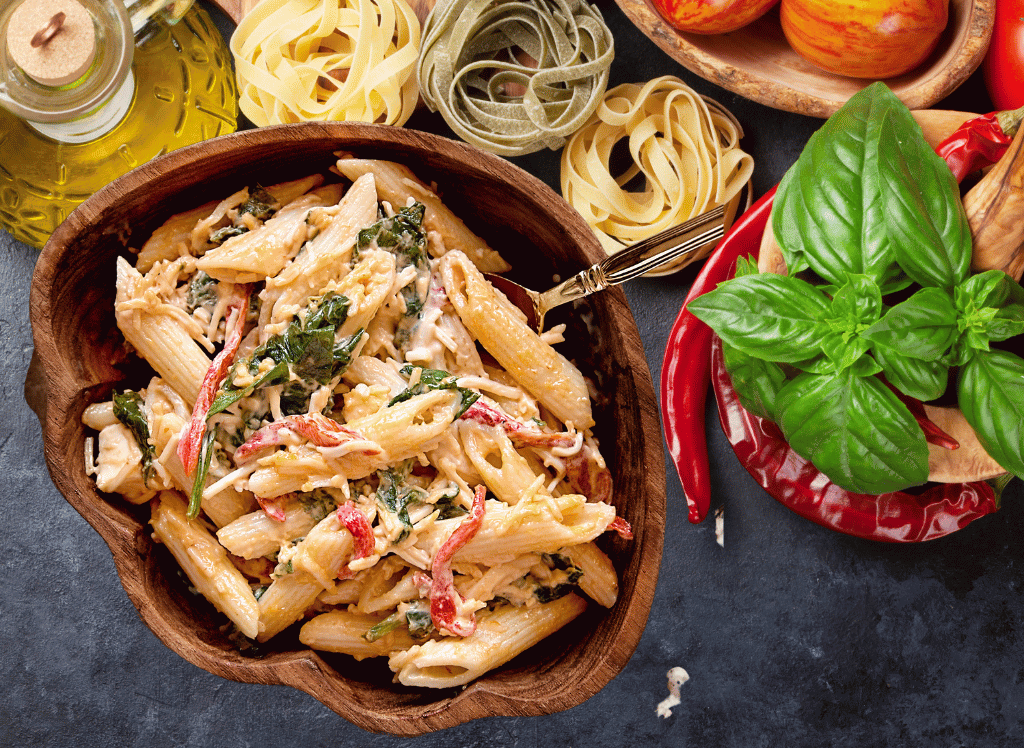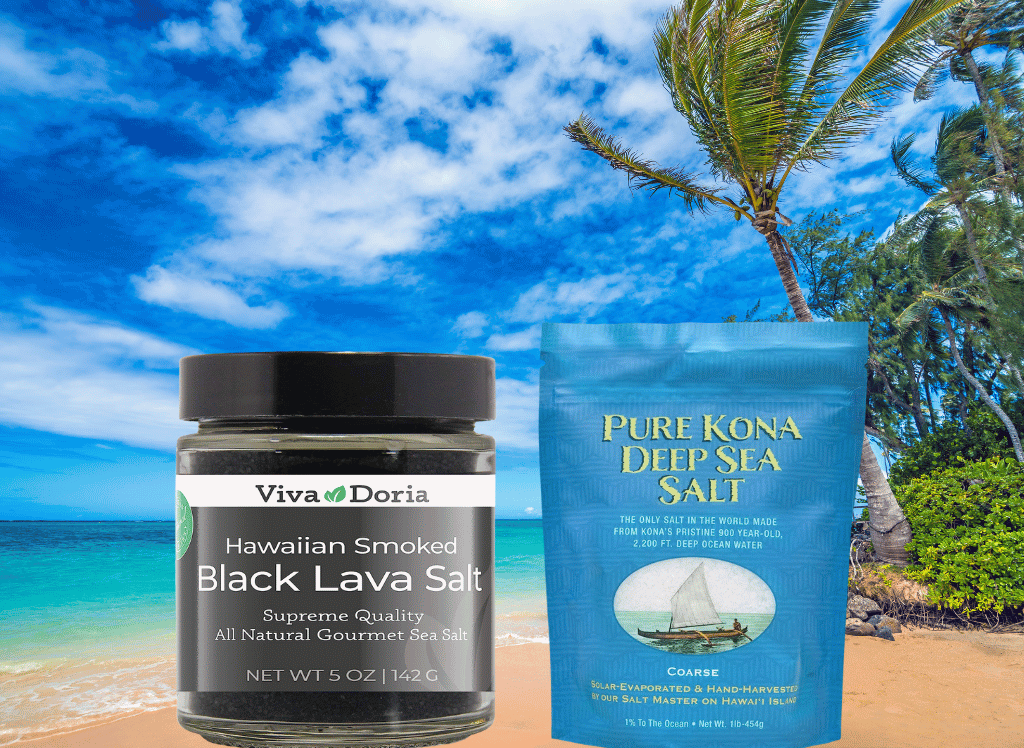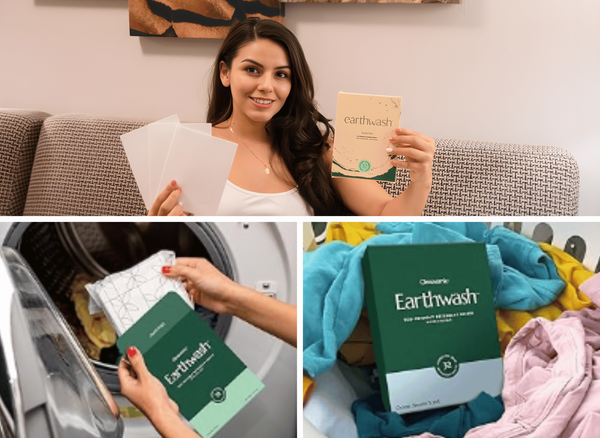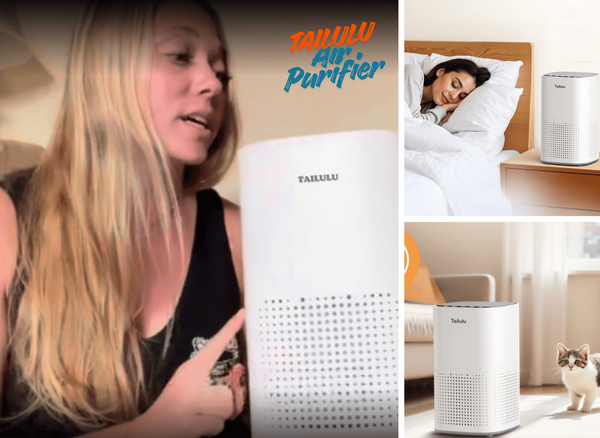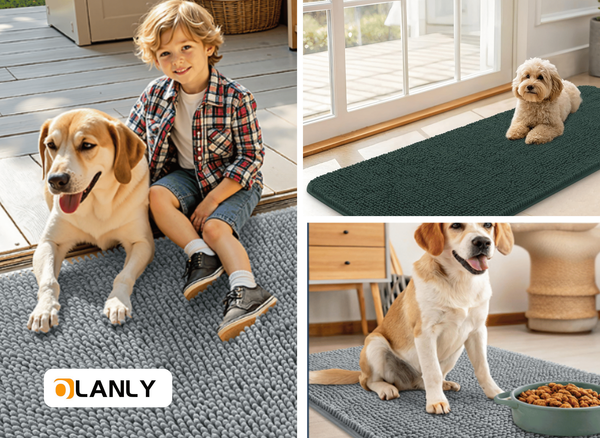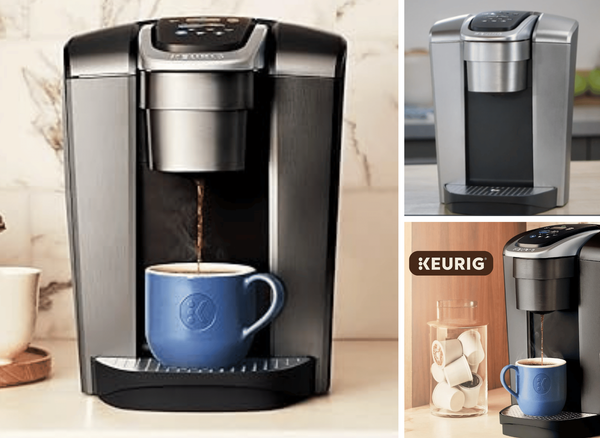Welcome to FactsFanatics. Feel free to add items to your cart as you browse. As an Amazon Associate, we earn from qualifying purchases (at no cost to you) from links found within these pages if you choose to buy something.
Food waste costs the average American household nearly $1,500 per year. Meanwhile, meal prep enthusiasts spend hours organizing their weekly meals, only to watch fresh ingredients spoil before they can use them. Enter the vacuum sealer machine—a kitchen appliance that's revolutionizing how we store, preserve, and prepare food products.
Vacuum sealing removes air from specially designed bags or containers, creating an airtight seal that dramatically extends food freshness and preserves essential nutrients. This process can keep meat fresh for weeks instead of days, preserve garden harvests through winter months, and make meal prep for sauces more efficient than ever before.
This comprehensive guide will walk you through everything you need to know about the best vacuum sealer machines. You'll learn about different types available, how to choose the right model for your needs, and discover creative uses that go far beyond basic food storage.
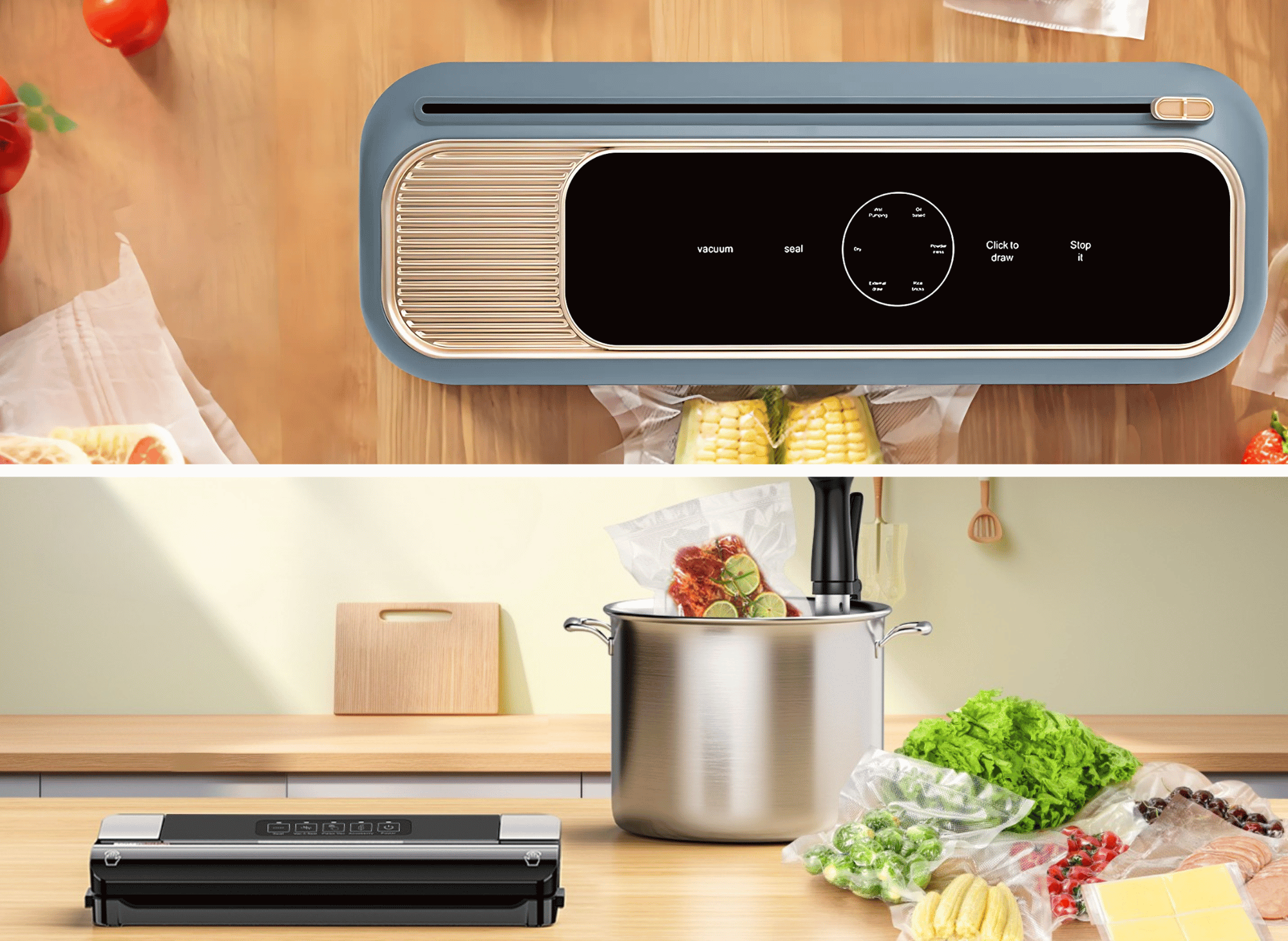
Introduction to Vacuum Sealing
Vacuum sealing is a powerful food preservation technique that works by removing air from specially designed bags or containers, creating a vacuum environment that keeps food fresh for much longer than traditional storage methods.
Using a vacuum sealer machine, you can dramatically extend the shelf life of your groceries by slowing down the growth of bacteria, mold, and yeast—organisms that thrive in the presence of oxygen. This process is especially valuable for meal prep enthusiasts, bulk buyers, and anyone looking to reduce food waste when preparing chicken and save money on groceries.
Vacuum sealers come in a variety of styles, from compact handheld vacuum sealers perfect for small kitchens or travel, to robust chamber vacuum sealers designed for heavy-duty use. No matter which type you choose, vacuum sealing is an essential tool for modern food storage and food preservation, especially when machines are user-friendly. By investing in a vacuum sealer, you can enjoy fresher food, make the most of bulk purchases, and keep your pantry, fridge, and freezer organized and efficient.
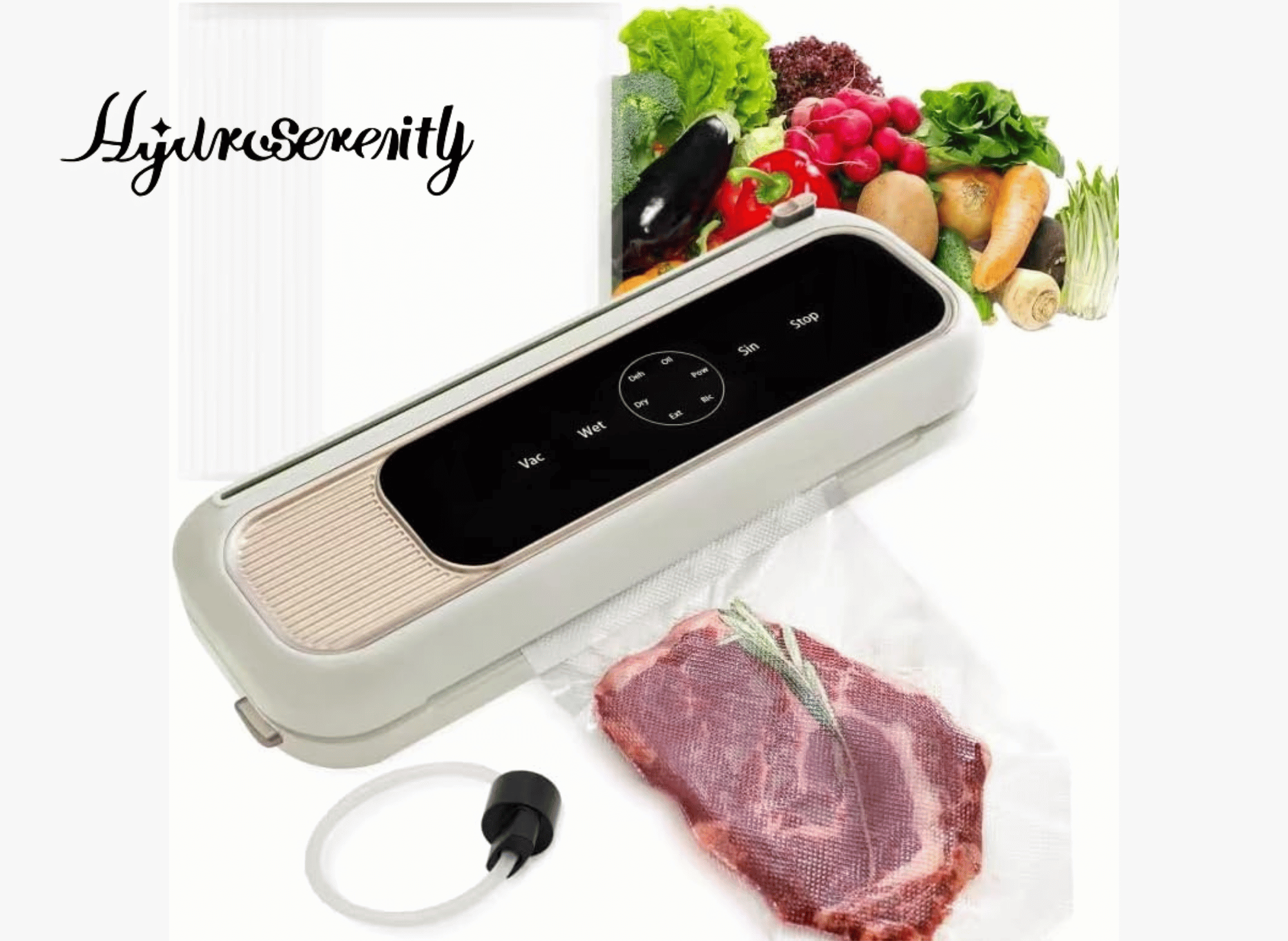
Hydroserenity Vacuum Sealer Machine
Precision Compact mini vacuum sealer 80 Kpa Powerful Suction, Automatic Operation, Ideal for Easy & Efficient Food Preservation and Storage With 10 Bags (White)
What Makes Vacuum Sealer Machines Essential for Modern Kitchens
Vacuum sealer machines work by removing oxygen from packaging, which is the primary culprit behind food spoilage. When oxygen interacts with food, it causes oxidation, bacterial growth, and freezer burn. By eliminating this air, vacuum sealers can extend the shelf life of dry, moist, refrigerated foods by 3-5 times and frozen foods by 2-3 times their normal duration.
Most foods, including meats, produce, and baked goods, can be effectively vacuum sealed for extended freshness, making vacuum sealers a versatile tool for preserving a wide range of items.
The benefits extend beyond preservation. Vacuum sealing prevents cross-contamination in your refrigerator, saves significant storage space by compressing bulky items, and allows you to buy ingredients in bulk without worrying about waste. For busy families, this means fewer grocery trips and substantial savings on your food budget.
Professional chefs have relied on vacuum sealing for decades, particularly for sous vide cooking techniques. Now, home versions make these same benefits accessible to everyday cooks who want restaurant-quality results in their own kitchens.
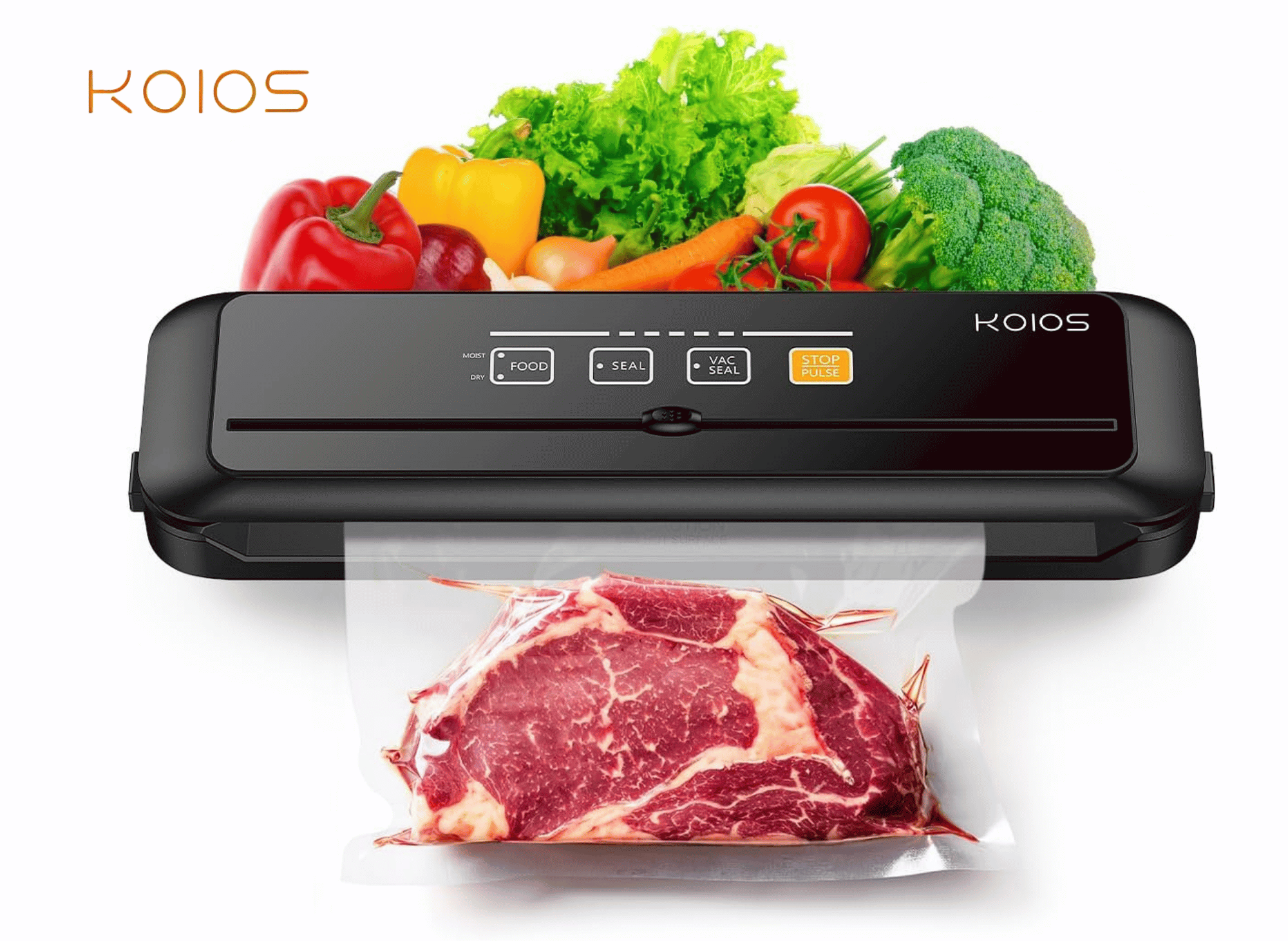
KOIOS Vacuum Sealer Machine
90 Kpa Automatic Vacuum Air food sealer/Built-in Cutter Starter Kit, Dry & Moist Food Preservation Modes, Pulse Function, LED
Types of Vacuum Sealer Machines: Finding Your Perfect Match
Chamber Vacuum Sealers
Chamber vacuum sealers represent the premium tier of vacuum sealing technology. These machines place the entire bag inside a chamber, remove air from both the bag and chamber simultaneously, making them ideal for advanced users, then seal the bag before releasing the vacuum.
This compact design allows chamber sealers to handle liquids, marinades, and wet foods without the mess that typically accompanies other vacuum sealing methods. Many chamber vacuum sealers also offer a double seal feature for extra protection against leaks, especially when sealing moist or liquid-rich foods. They’re also incredibly fast, processing multiple bags in succession without overheating.
However, chamber vacuum sealers require significant counter space and investment. They’re best suited for serious home cooks, hunters who process large amounts of meat, or small food businesses that need commercial-grade capabilities.
External Vacuum Sealers
External vacuum sealers are the most popular choice for home kitchens. These machines draw air directly from the bag through an external nozzle, then heat-seal the opening to create an airtight package.
They come in both countertop and handheld versions. Countertop models offer more power and consistency, making them ideal for regular meal prep and bulk food storage. Most include additional features like adjustable suction levels for delicate items and pulse settings for better control.
Many external vacuum sealers also feature a pulse button and a gentle setting, which are especially useful for sealing delicate or crushable foods without causing damage.
The main limitation of external sealers is their difficulty handling liquids or very moist foods, which can interfere with the sealing process. Despite this constraint, they handle the vast majority of home food preservation tasks effectively.
Handheld Vacuum Sealers
Handheld vacuum sealers provide a compact, portable solution for occasional vacuum sealing needs. These battery-operated devices work with specially designed bags or containers that have one-way valves.
While handheld models can't achieve the same vacuum strength as larger machines, they're perfect for travelers, small apartments, or quick tasks like resealing opened packages. They're also excellent for vacuum sealing non-food items like documents or seasonal clothing.
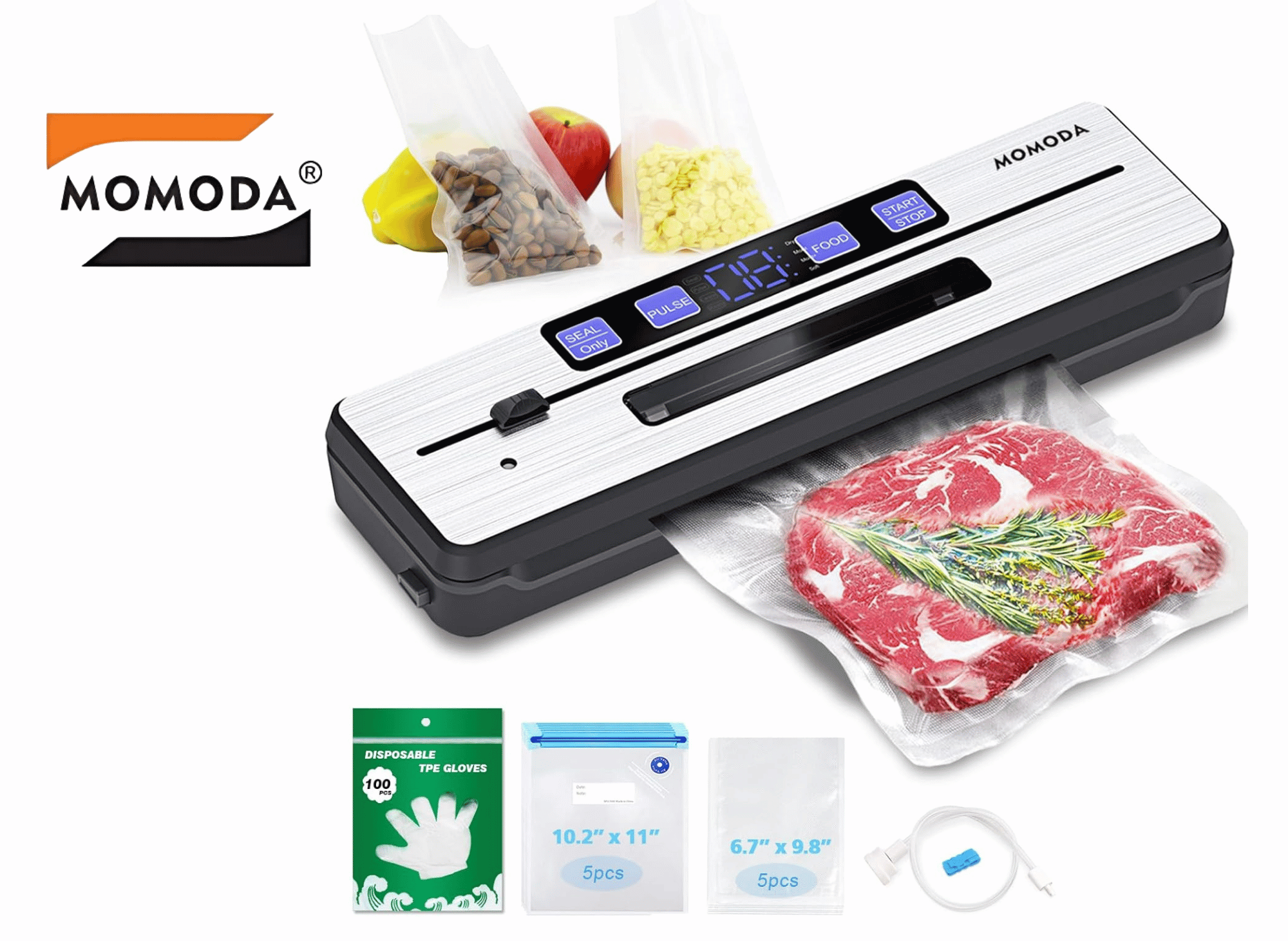
MOMODA Vacuum Sealer Machine with Starter Kit
80 KPa Automatic Food Sealer, 8-in-1 with Disposable Bags, Moist&Dry Mode, External VAC for Food Storage
How to Choose the Right Vacuum Sealer Machine
Assess Your Volume and Frequency Needs
Start by honestly evaluating how often you’ll use your vacuum sealer. Occasional users who want to preserve leftovers or reseal opened packages can thrive with a basic external sealer or handheld model.
Frequent users—such as dedicated meal preppers, hunters, or gardeners—benefit from investing in a higher-powered countertop external sealer or even a chamber model. These machines handle continuous use better and offer more consistent results. They are specifically designed to operate efficiently over an extended period without overheating or requiring long rest times.
Consider Your Food Types
Different foods require different vacuum sealing approaches. If you primarily seal dry goods like nuts, crackers, or dried fruits, any external sealer will work well. These foods don’t present moisture challenges and seal easily. For delicate foods, such as berries or soft fruits, a vacuum sealer with a gentle or pulse setting is recommended to prevent crushing and maintain their integrity, ensuring they remain delicious .
For those who regularly work with marinades, soups, or other liquid-containing foods, a chamber vacuum sealer becomes almost essential. The ability to seal liquids without a mess opens up numerous meal prep possibilities that other machines simply can’t handle.
Raw meat requires special consideration. Look for machines with strong suction power and reliable sealing mechanisms, as proper meat preservation is crucial for food safety.
Evaluate Available Storage Space
Vacuum sealers range from compact handheld units to substantial countertop appliances. Measure your available storage space before shopping, keeping in mind that you’ll also need room to store vacuum sealing bags and accessories.
Some countertop models include built-in bag storage and cutting mechanisms, which can actually save space by consolidating multiple functions into one appliance. Additionally, certain vacuum sealer machines feature a compartment for a bag roll, allowing users to create custom-sized bags and further optimize storage space.
Budget Considerations
Entry-level external vacuum sealers start around $30-50 and can handle basic sealing tasks effectively. Mid-range models ($75-150) typically offer better build quality, more consistent performance, and useful features like adjustable vacuum strength.
High-end external sealers and entry-level chamber models range from $200-500, while professional-grade chamber sealers can exceed $1,000. Remember that a quality vacuum sealer pays for itself through reduced food waste and bulk buying opportunities. When choosing within your budget, consider looking at best seller models in your price range, as these often combine strong performance with positive customer reviews.
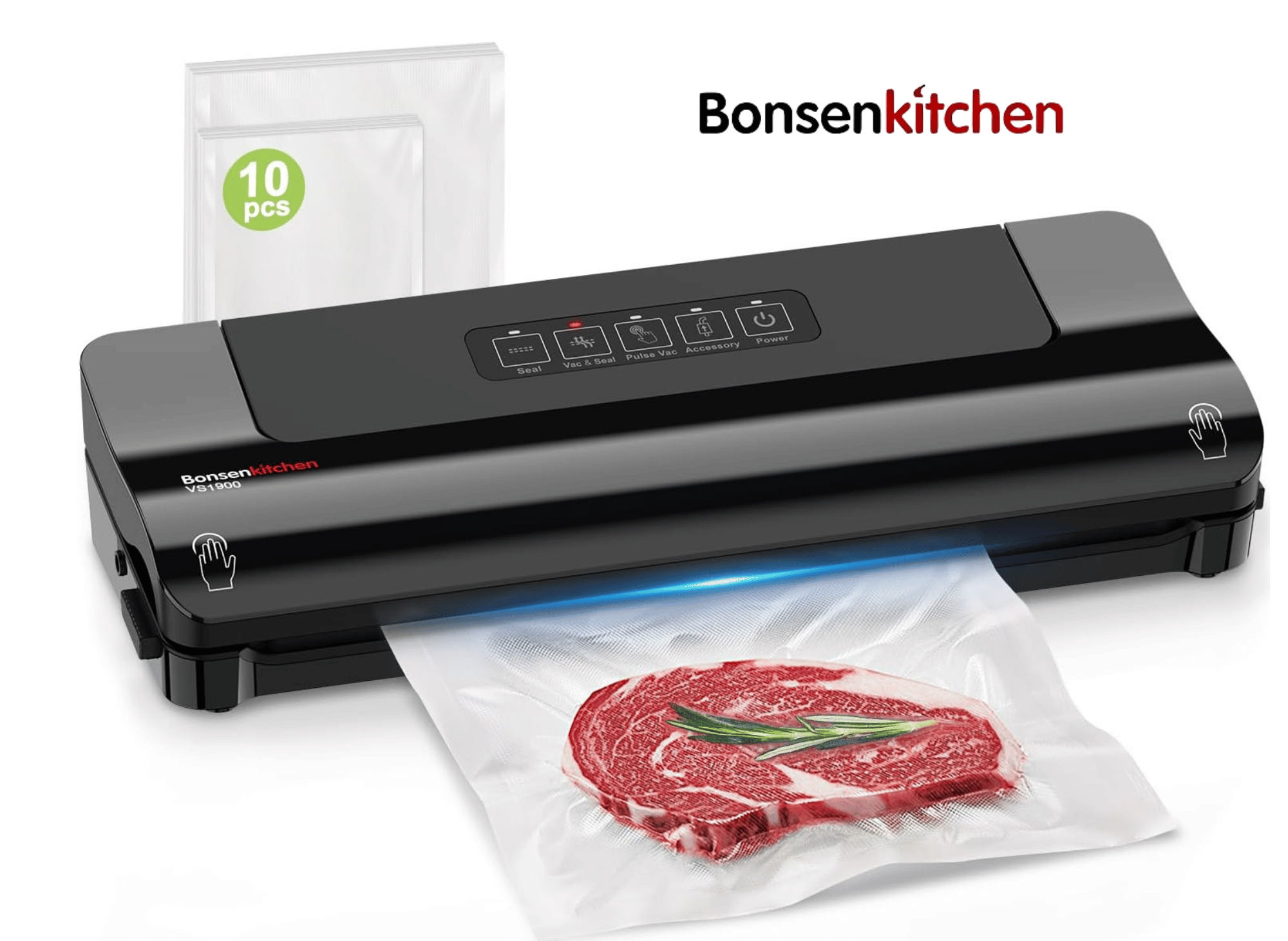
Bonsenkitchen Vacuum Sealer Machine
Multi-Functional Food Sealer with 10 Vacuum Bags, Fast-Compact Design, External Vacuum System & Accessory Tube for Freshness Preservation
Accessories and Supplies for Vacuum Sealing
To get the best results from your vacuum sealer machine, it’s important to have the right accessories and supplies on hand. The foundation of any vacuum sealing system is the vacuum sealer bag—these specially designed bags, available as rolls or pre-cut bags, are made from thick, durable plastic with a textured interior to ensure a strong, airtight seal. Many users appreciate the convenience of pre-cut bags for quick sealing, while bag rolls allow you to customize the size for different food items.
Additional accessories can make vacuum sealing even easier and more efficient. A bag cutter helps you create perfectly sized bags, while a sealing bar ensures a consistent, reliable seal every time. Some vacuum sealer machines come with a starter kit that includes a handheld sealer, an air suction hose for canisters or containers, and built-in bag storage to keep your supplies organized.
For those looking to reduce waste and save money, reusable bags are a great option—they can be washed and used multiple times without sacrificing seal quality. With the right combination of bags, tools, and accessories, your vacuum sealing experience will be smooth, efficient, and cost-effective.
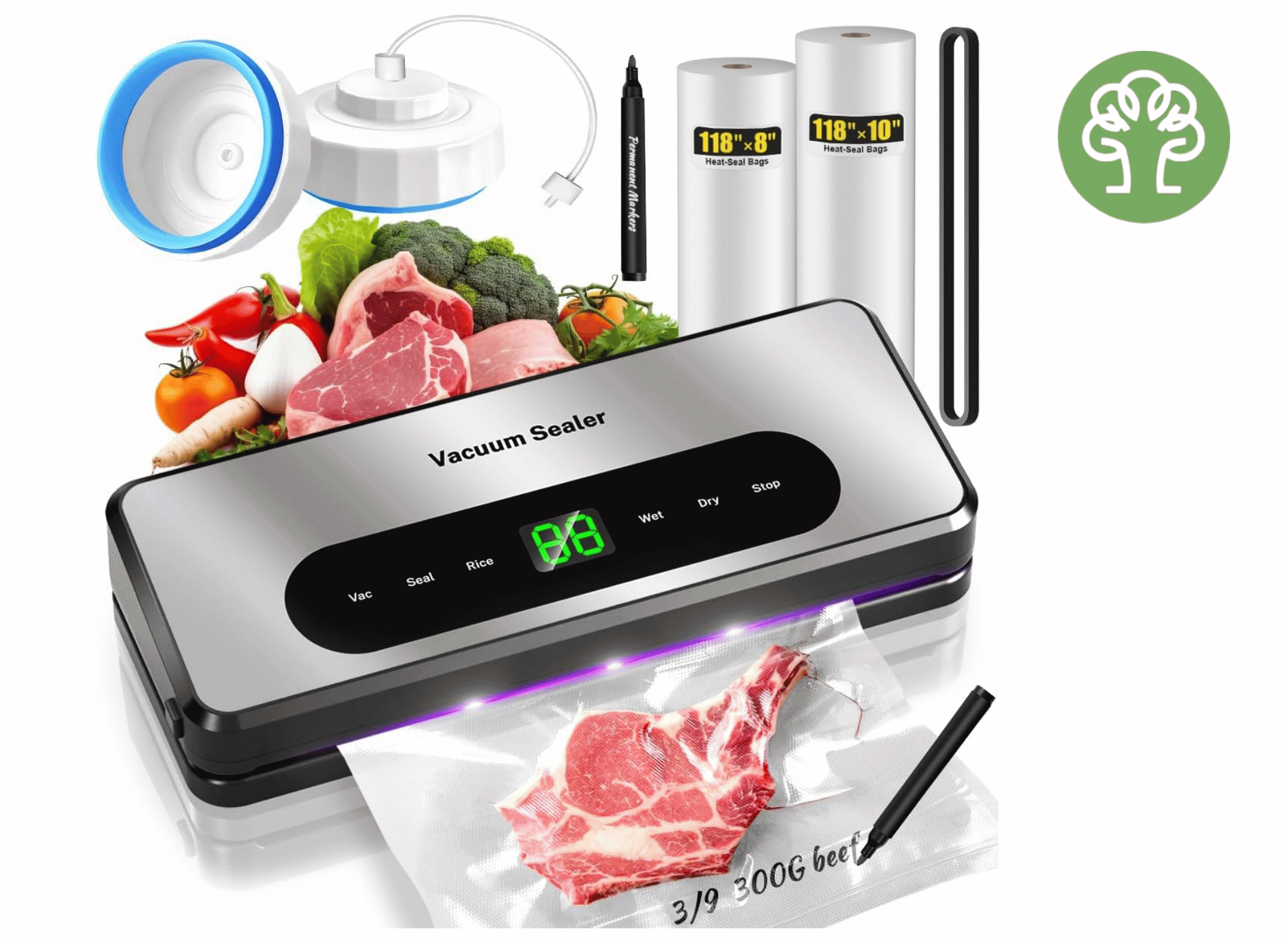
Gyreuni 8 in 1 Food Vacuum Sealer Machine
Canning Sealer,Multi-function Food Sealer Built-in UV Cutter/Bag Storage Act on Dry Wet oil Crispy, Vacuum Sealer with Cutter Attached 2 Bag Rolls/Marker Pen
Step-by-Step Guide to Using Your Vacuum Sealer Machine
Preparing Your Food for Sealing
Start with clean, dry hands and sanitized surfaces. Pat any meat or fish completely dry with paper towels, as excess moisture can interfere with the sealing process. For fruits and vegetables, ensure they’re clean and thoroughly dried. Foods should be properly bagged to achieve a strong, airtight vacuum seal and prevent air seepage.
Pre-freeze items with sharp edges or bones for 1-2 hours before sealing. This prevents the frozen items from puncturing the bag during the vacuum process. Alternatively, wrap sharp items in a paper towel before placing them in the vacuum bag.
Note: Certain foods, such as raw onions, should not be vacuum sealed due to potential health risks like botulism.
Loading and Positioning
Cut your vacuum sealer bag 3-4 inches longer than your food item to ensure adequate space for sealing. For best results, always use vacuum sealer bags, as they are specially designed for proper air removal and preservation. Open the bag completely and insert your food, leaving at least 3 inches of empty space at the top.
For external vacuum sealers, ensure the open end of the bag lies completely flat across the sealing area. Any wrinkles or folds can create air leaks that compromise your seal. Proper positioning is essential to achieve a strong, airtight sealed bag.
Operating the Machine
Close the vacuum sealer lid and select your desired settings. Most machines offer normal and gentle settings, with gentle being appropriate for delicate items like bread or soft fruits. Some models also include a pulse setting or pulse function, which allows you to manually control the vacuum process for even greater precision when sealing delicate or soft foods, preventing crushing or damage.
Press the vacuum and seal button (or the combined function button on simpler models). Watch the bag compress as air is removed. The machine will automatically stop vacuuming and begin heat sealing when optimal vacuum is achieved.
Finishing and Quality Check
Once the sealing cycle completes, wait a few seconds before opening the lid. This allows the heat seal to cool and strengthen. Remove your sealed package and inspect the seal line. It should appear smooth, consistent, and completely fused across the entire width.
Test your seal by gently pulling on both sides of the sealed area. A proper seal won’t separate under reasonable pressure. A strong seal is essential for preventing air leaks and ensuring long-term food preservation. If you notice any gaps or weak spots, trim the bag just above the original seal and reseal.
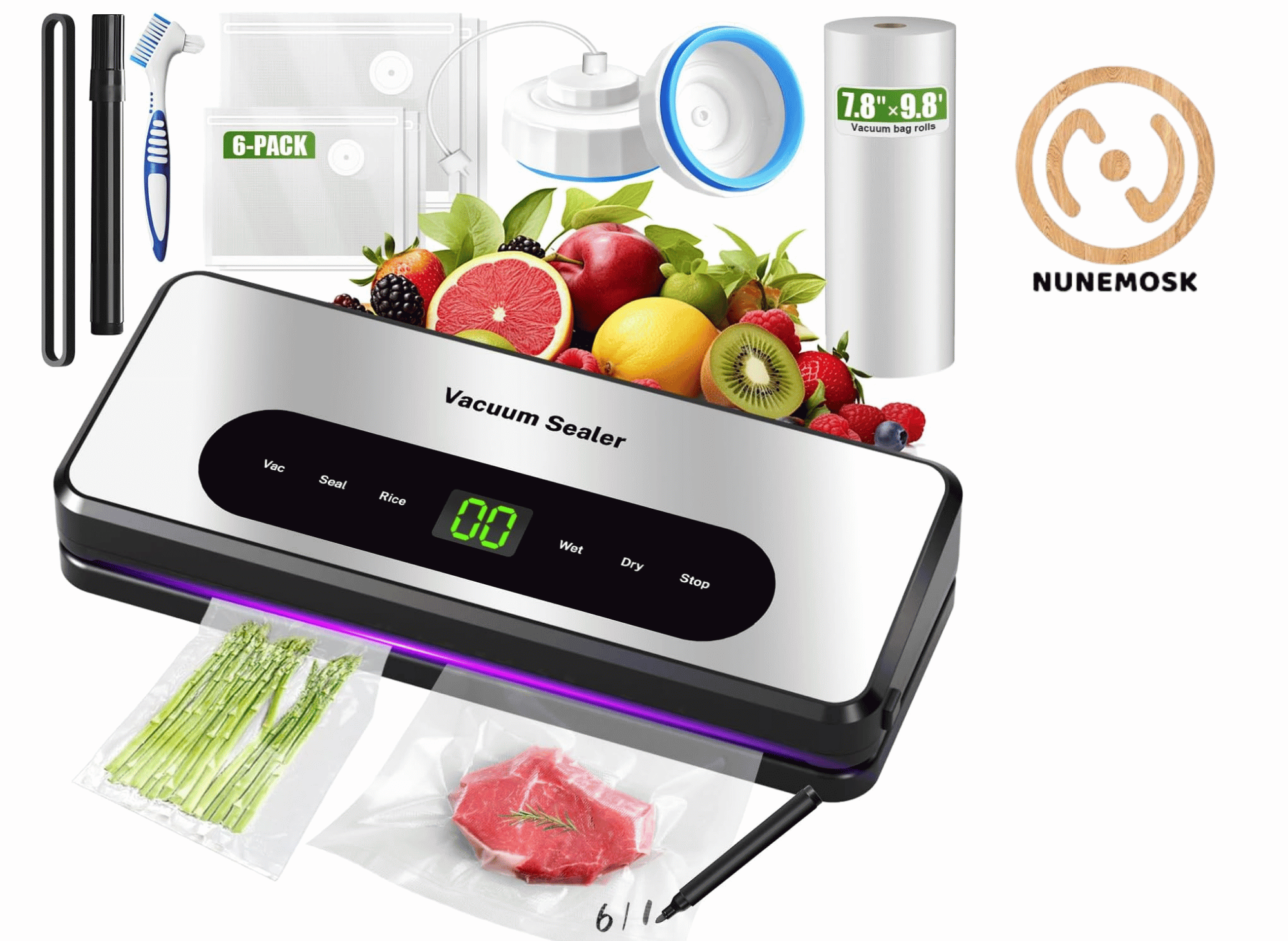
Nunemosk Vacuum Sealer for Food
Food Saver Vacuum Sealer Machine, Powerful Suction, Build-in Cutter, UV Compact Food Sealer, Dry&Wet Modes, Vacuum Sealer Kit with Bag Roll&Mason Jars&Reusable Vacuum Seal Bags
Tips and Tricks for Effective Vacuum Sealing
Maximizing Seal Quality
Clean the sealing area regularly with a damp cloth to remove any food particles or oils that might interfere with proper sealing. Even small debris can create gaps that allow air to leak back into your packages.
For particularly moist foods, place a paper towel at the top of the bag before sealing. This absorbs excess moisture and prevents it from reaching the sealing area, where it could cause seal failure.
If you need to vacuum seal liquids, it's best to freeze them first. Freezing liquids before sealing helps prevent spills and ensures a proper, airtight seal.
For best results, consider choosing tested vacuum sealers with proven performance across different food types, including liquids and delicate items.
Protecting Delicate Items
Use the pulse vacuum feature when available to control the vacuum strength manually. This prevents over-compression of delicate items like berries, chips, or bread that could be crushed by full vacuum pressure.
Consider pre-freezing soft fruits or arranging them in a single layer within the bag. Frozen items maintain their shape better during the vacuum process and thaw with better texture retention.
Zipper bags are also a convenient option for storing delicate foods that need to be accessed or resealed often.
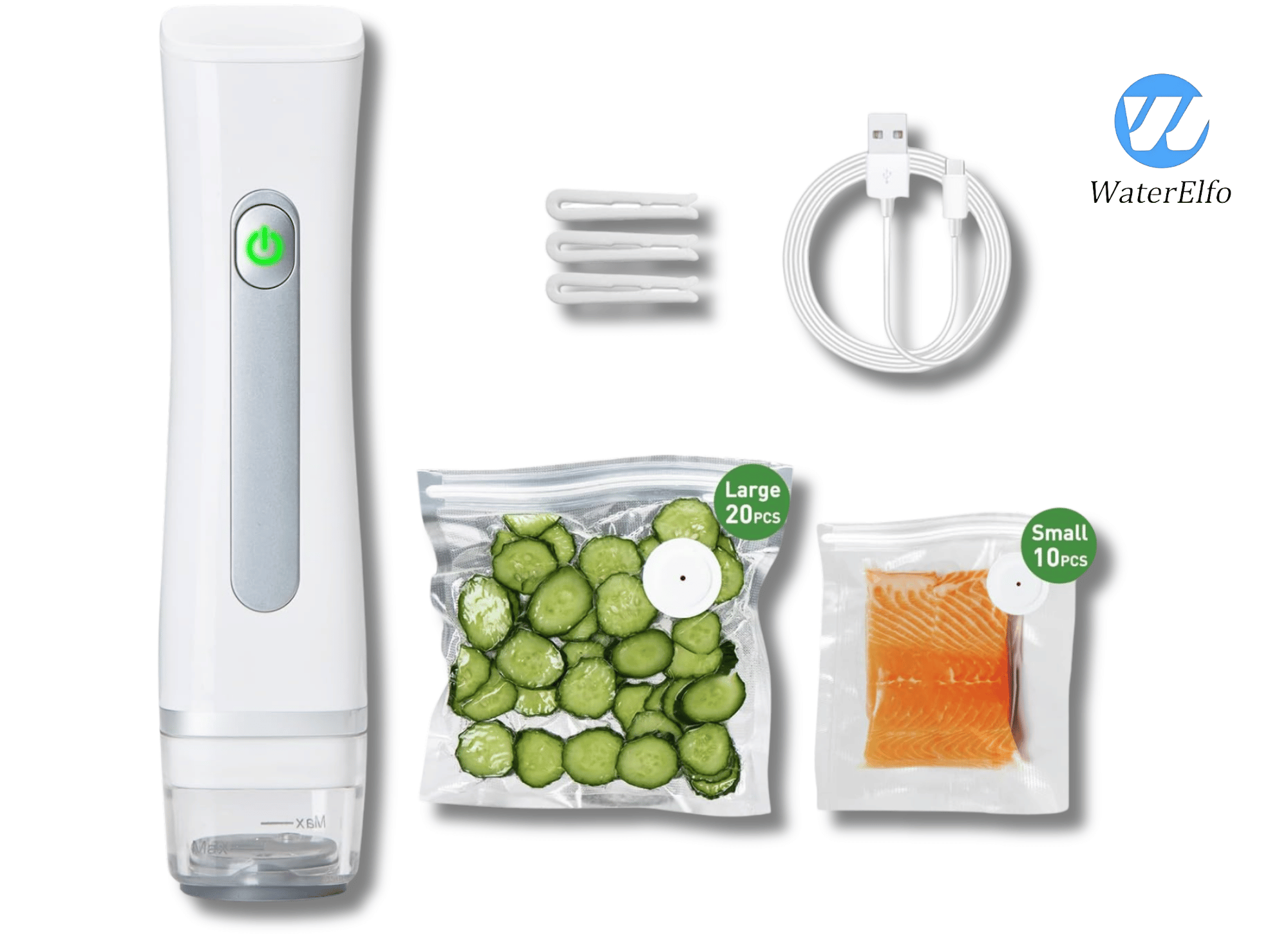
Waterelfo Vacuum Sealer for Food
Powerful Handheld Vacuum Sealer Machine With 30 Reusable Vacuum Bags, Portable Food Sealer, Automatic Power Off, White
Batch Processing Efficiency
Prepare multiple items for sealing before starting your machine. This allows you to work through several packages efficiently while the sealer remains at optimal operating temperature.
Keep pre-cut bags in various sizes readily available. Having the right size bag immediately accessible speeds up the sealing process and reduces waste from oversized packages.
Storage and Organization After Sealing
Proper longer storage is key to maximizing the benefits of vacuum-sealed food. Once you’ve sealed your food items, it’s important to store the vacuum-sealed bags in the right environment to maintain freshness and extend shelf life.
Vacuum-sealed foods can be kept in the freezer, refrigerator, or pantry, depending on the type of food and how long you plan to store it. For best results, always label and date your sealed bags of food stored so you can easily track what’s inside and when it was sealed.
To further protect your vacuum-sealed bags, consider storing them in airtight containers or bins, especially if you’re placing them in the pantry or freezer. This extra layer of protection helps prevent moisture, pests, and other contaminants from affecting your food.
Many other vacuum sealers also feature roll storage compartments, making it easy to keep unused bag rolls organized and within reach. By taking a few simple steps to organize and store your vacuum-sealed foods, you’ll enjoy longer-lasting freshness and a more efficient kitchen.

COZII Compact Vacuum Sealer for Food
30 Reusable Bags,Powerful Handheld Vacuum Sealer Machine with Visible Water Tank for 6X Preservation Fresh, White
Creative Uses Beyond Food Storage
Sous Vide Cooking Preparation
Vacuum sealing is essential for sous vide cooking, which involves cooking food in precisely controlled water baths. The vacuum-sealed environment ensures even heat distribution and prevents water from diluting flavors.
For sous vide preparation, add seasonings, herbs, or marinades directly to the bag with your protein or vegetables. The vacuum environment intensifies flavor infusion while the controlled cooking temperature ensures perfect doneness throughout.
Non-Food Applications
Vacuum sealers excel at protecting non-food items from moisture, air, and pests. Seal important documents, photos, or certificates before storing them in safes or safety deposit boxes.
Compress seasonal clothing or bedding for more efficient storage. Vacuum-sealed comforters and winter clothes take up 75% less space in closets or under-bed storage areas.
Travel and Emergency Preparedness
Create compact travel kits by vacuum sealing toiletries, medications, or electronics accessories. The airtight environment protects items from moisture damage while minimizing luggage space.
Build emergency food supplies that maintain nutritional value and flavor for extended periods. Vacuum-sealed emergency rations resist spoilage and pest infiltration better than traditional storage methods.

Hsjayah Handheld Vacuum Sealer for Food
Portable Rechargeable Wireless Vacuum Sealer with 10 Reusable Vacuum Seal Bags
Maintenance and Troubleshooting Your Food Vacuum Sealer Machine
Keeping your vacuum sealer machine in top condition is essential for reliable performance and long-term durability. After each use, take a moment to clean the sealing bar and accessory port with a damp cloth to remove any food particles or residue—a crucial job for maintaining performance. Don’t forget to wipe down the lid and regularly check the air suction hose for clogs or buildup, as these can affect the machine’s ability to create a strong vacuum.
If you encounter issues such as weak seals, bag punctures, or inconsistent vacuuming, consult your user manual or the manufacturer’s website for troubleshooting tips. Many common problems can be resolved by cleaning the sealing area, checking for proper bag placement, or replacing worn parts.
Replacement sealing bars, bag cutters, and other components are often available to help keep your sealer machine running smoothly. With regular maintenance and prompt troubleshooting, your vacuum sealer will continue to deliver excellent results, helping you preserve food and reduce waste for years to come.
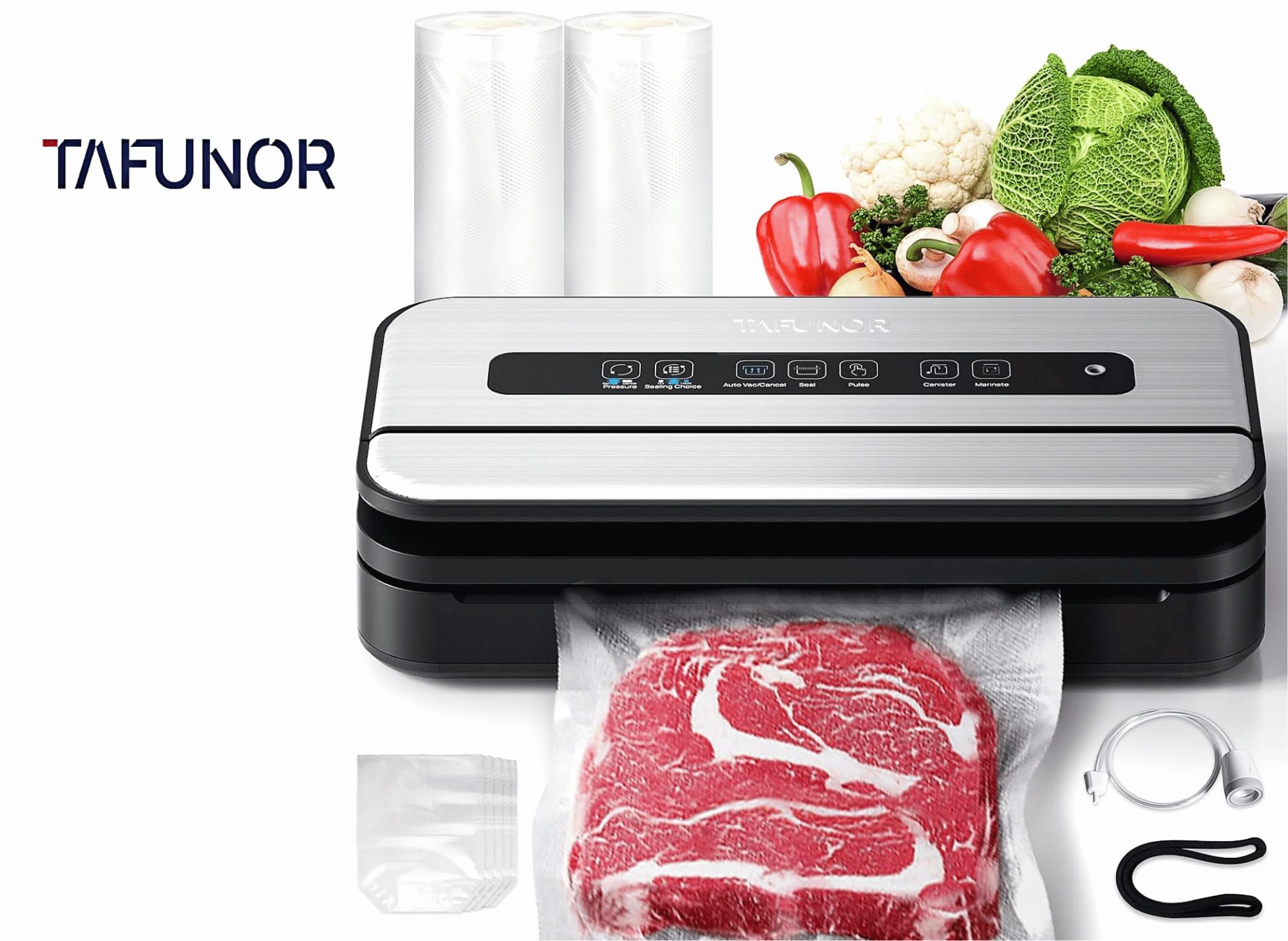
Tafunor Vacuum Sealer Machine
2025 Updated Stylish design Precision Vacuum Sealer Machine Pro for Food Saver, Concealed Handle 90Kpa Vacuum Sealers for Sous Vide, Liquid Food/Build with Cutter/Large Bag Storage/2 Bag Rolls
Common Mistakes to Avoid When Vacuum Sealing
Overpacking Bags
Cramming too much food into a single bag creates stress points that can compromise seal integrity. It also makes it difficult to achieve proper vacuum levels throughout the package.
Instead, use multiple smaller bags for large quantities of food. This approach actually provides better protection and allows you to use portions without exposing the entire quantity to air.
Sealing Hot Foods
Never attempt to vacuum seal foods that are still warm from cooking. Hot foods create steam that can interfere with sealing and damage your machine's internal components.
Allow all cooked foods to cool completely to room temperature before sealing. For faster cooling, spread items on a sheet pan and refrigerate for 30-60 minutes before vacuum sealing.
Ignoring Liquid Limitations
External vacuum sealers struggle with liquids because the suction can draw liquid into the machine, causing damage and poor seals. If you must seal liquids with an external sealer, freeze them solid first, then seal the frozen block.
When it comes to choosing the favorite vacuum sealers, it's essential to find a balance between functionality and ease of use. For advanced users, models with canister mode offer versatile options for sealing various items, ensuring that all the air is effectively removed to preserve freshness.
However, even beginners credit user-friendly designs that make the process straightforward without compromising performance. Whether you're a professional food writer or just starting in meal prepping, there's a vacuum sealer tailored to your needs.
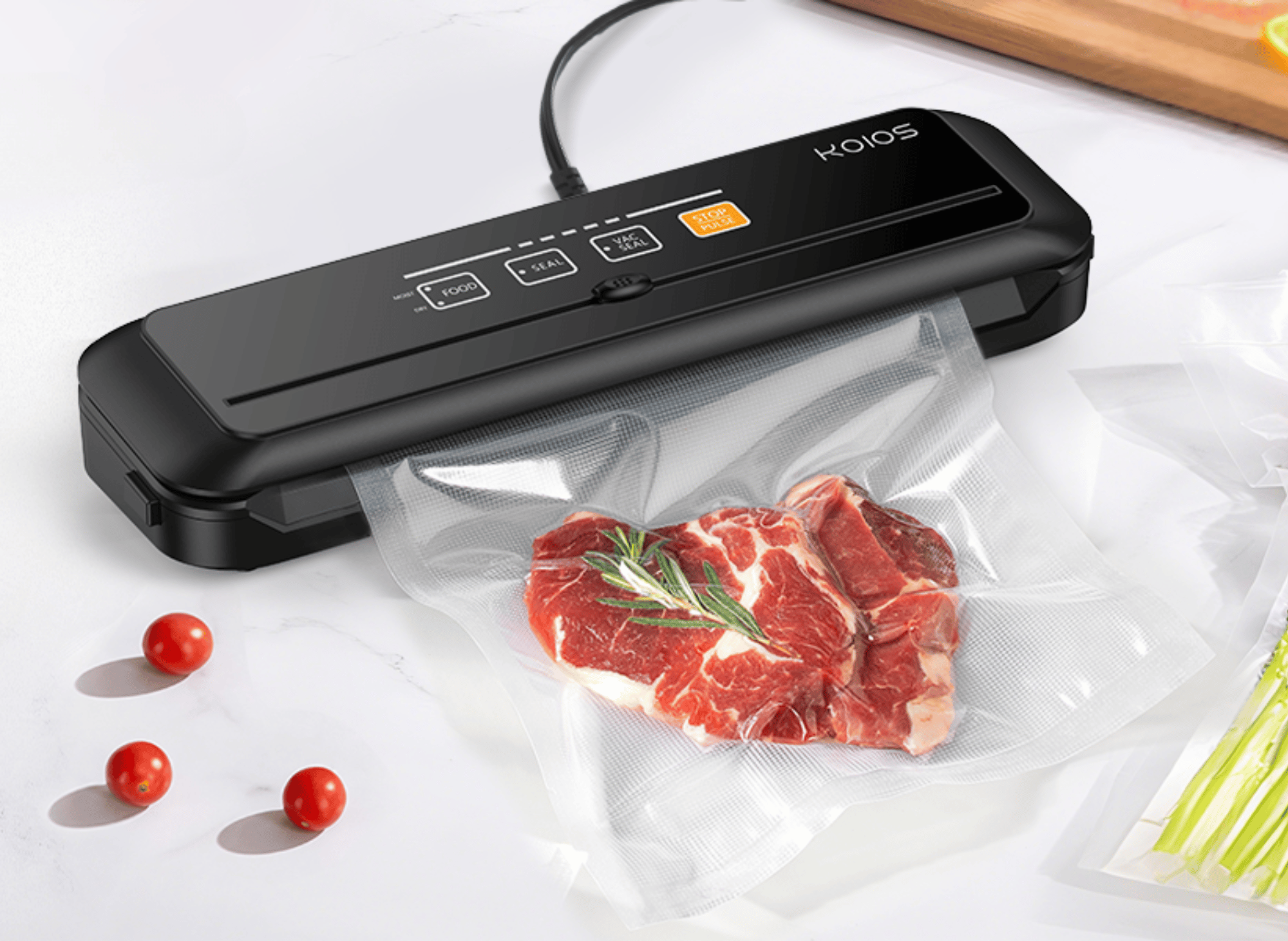
Our Final Thoughts
In conclusion, choosing the right vacuum sealer can make a significant difference in preserving the freshness and quality of your food. With numerous options available, it's crucial to consider your specific needs and preferences, including portability, ease of use, and durability. A reliable vacuum sealer is a valuable investment for anyone seeking to minimize food waste and prolong the shelf life of their favorite ingredients.
Thank you for reading!
Your friend,
Kelly
#FoodVacuumSealer #FreshnessMatters #KitchenEssentials #MealPrepMadeEasy #SaveYourFood #FoodStorageSolutions #PreserveFlavor #HealthyLiving #EcoFriendlyKitchen #SmartCooking
🍎 🥩 🥗 🥖 🧀 🥶 🕒 🍱 ✅ 🌟
Amazon Prime offers a wide range of products designed to cater to diverse customer needs, all with the added benefit of fast, reliable delivery. From household essentials and groceries to electronics, clothing, and entertainment, Prime members get access to exclusive deals and discounts across various categories.
Additionally, Prime membership includes access to services like Prime Video for streaming movies and TV shows, Amazon Music for ad-free music, and Prime Reading for eBooks and magazines. This comprehensive suite of benefits makes Amazon Prime a convenient and value-packed option for millions of customers worldwide.
- Prime for you, adult
- Free 30-day trial of Prime
- All of Prime, half the price.
- Prime Video
- wedding registry
- Kindle Unlimited
- Amazon Music
- Amazon Fresh Groceries
